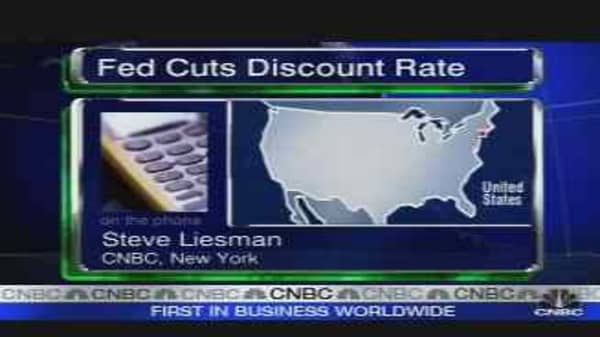The U.S. Federal Reserve on Sunday announced emergency measures to stem a fast-spreading global financial crisis, tapping tools last used in the Great Depression to pour funds into cash-starved Wall Street firms.
The Fed cut the discount rate it charges on direct loans to banks to 3.25 percent from 3.50 percent and set up a new program to provide cash to a wider range of big financial firms previously unable to borrow directly from the central bank.
It took the steps in concert with a decision to approve special financing to facilitate the purchase of ailing investment bank Bear Stearns by JPMorgan Chase. . Under the deal, the Fed agreed to fund up to $30 billion of Bear Stearns' less liquid assets.
Senior Fed officials said the extraordinary measures, which extend a series of emergency steps taken over the last 10 days, were needed to ensure a broad spectrum of financial firms had access to funds after problems at Bear Stearns late last week.
"The Federal Reserve, in close consultation with the Treasury, is working to promote liquid, well-functioning financial markets, which are essential for economic growth," Fed Chairman Ben Bernanke said in a rare conference call with reporters. "These steps will provide financial institutions with greater assurance of access to funds."
The shock move late on Sunday harkened back to the days of then-Fed Chairman Paul Volcker, who engineered a surprise increase in interest rate on a Saturday in early October 1979.
Asset-Backed Securities Markets
This time, however, the problem was quickly deteriorating financial conditions, which threaten to push an economy many think is already in recession into a deep, nasty downturn.
The central bank cut the discount rate with immediate effect to a level just a quarter point above the interbank overnight federal funds rate, its main lever to influence the economy.
The action came just two days before Fed officials gather for a regularly scheduled meeting and it led financial markets to expect an even more-aggressive cut in the federal funds rate when the meeting wraps up on Tuesday.
Interest rate futures prices shifted to fully price in an expected 1 percentage point cut, with some chance of an even bigger move -- reductions that would be unprecedented in the central bank's modern history. The Fed would be expected to lower the discount rate again by a matching amount.
In addition to cutting the discount rate, the central bank said it was setting up a new lending program under which so-called primary dealers could borrow directly from the Fed at the discount rate.
"This is designed to help get liquidity to where it can help play an appropriate role in helping address the range of challenges facing, particularly asset backed securities markets," New York Federal Reserve Bank President Timothy Geithner told reporters.
Shortly after the Fed announced its liquidity rescue and approval for JPMorgan's purchase of Bear Stearns, another financial firm fell victim to the financial crisis as Carlyle Capital announced it is filing for compulsory winding up.
The Fed's unusual weekend announcement came after several turbulent weeks in financial markets. Senior Fed officials, speaking on condition they not be named or quoted directly, said difficulties at Bear Stearns posed a major set of challenges for the financial system as a whole.
The timing of the announcement should be seen as driven by the situation at Bear Stearns, a senior official said.
Pre-empting Ad Hoc Lending
The central bank said the new lending facility for the primary dealers -- big Wall Street firms that deal directly with the Fed in financial markets -- would be open for business on Monday and would be kept in place for at least six months.
The Fed, which normally lends through its discount window only to banks that take deposits, can lend to nondepository institutions under special circumstances. It last did so in the 1930s.
The new facility is aimed "to improve the ability of primary dealers to provide financing to participants in securitization markets," the central bank said. The loans extended under the new program can be backed by a broad range of investment-grade debt securities as collateral.
Both actions were approved unanimously by the Fed's Board of Governors. The Fed also said it was increasing the maximum term for discount window loans to 90 days from 30 days.
On Friday, the Fed said it would provide emergency funds to cash-strapped Bear Stearns through its discount window using JPMorgan as an intermediary. Bear Stearns is one of the 20 primary dealers.
"This evening's decision appeared to pre-empt the possibility of continuing to arrange ad hoc lending arrangements to other primary dealers who could face funding difficulties," said Michael Feroli, an economist at JPMorgan.




